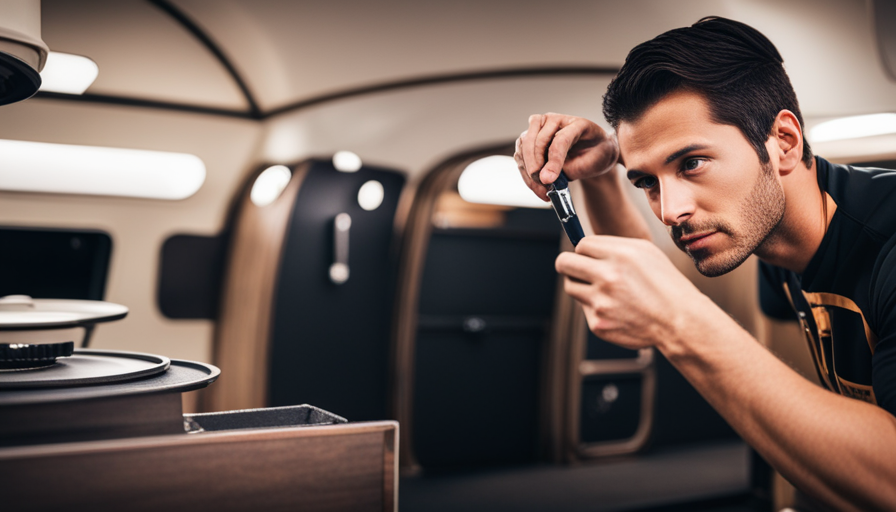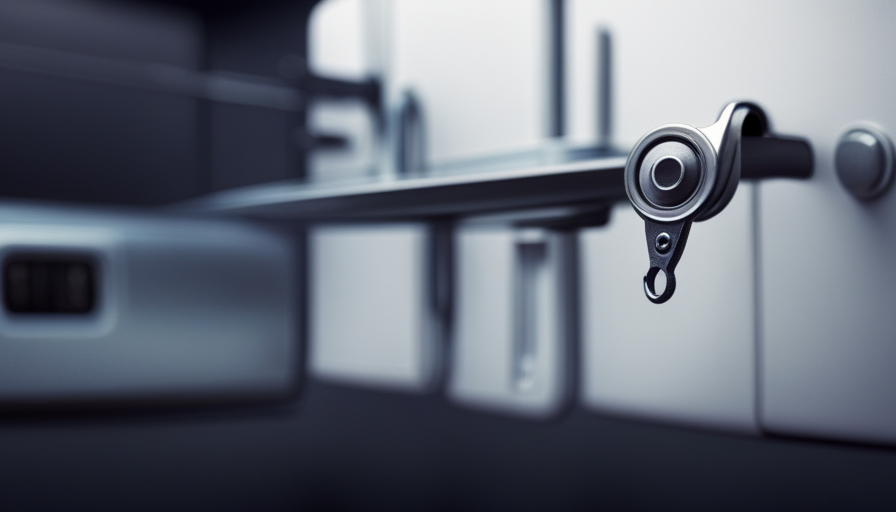Were you aware that over 10 million Americans are owners of campers or RVs? It’s hardly surprising these vehicles have gained such popularity, offering the ability to journey and roam the vast outdoors while retaining the conveniences of home.
However, over time, the cabinets in your camper can start to look worn and outdated. The good news is that you don’t have to live with drab laminate cabinets any longer. In this article, I will share with you my detailed and professional knowledge on how to paint laminate camper cabinets.
By following these steps, you can give your camper a fresh and modern look without breaking the bank. From gathering the necessary materials to reattaching the cabinet hardware, I will guide you through each step of the process.
So, let’s get started and transform your camper into a stylish and inviting space you’ll love.
Key Takeaways
- Painting laminate camper cabinets can give your camper a fresh and modern look.
- Lighter colors can create a brighter and more spacious feel, while bold and vibrant hues can add personality and charm.
- Steps for painting laminate camper cabinets include cleaning the cabinets thoroughly, sanding the surface, applying a primer specifically designed for laminate surfaces, and choosing the right paint for laminate surfaces.
- Maintenance and care tips for painted cabinets include using mild cleaner and a soft cloth for cleaning, avoiding abrasive cleaners or scrub brushes, using coasters or placemats to prevent water rings and stains, and considering applying a clear topcoat or sealer for added protection.
Gather the Necessary Materials and Tools
Now you’re ready to gather all the materials and tools you’ll need to transform your laminate camper cabinets into a stunning masterpiece! Choosing the right paint color is crucial to achieving the desired look for your cabinets. Opt for a paint color that complements the overall theme and style of your camper.
Consider using lighter colors to create a brighter and more spacious feel, or go for bold and vibrant hues to add personality and charm.
When it comes to painting laminate surfaces, there are a few important tips to keep in mind. Firstly, ensure that the paint you choose is specifically formulated for laminate materials. This will ensure better adhesion and durability. Secondly, it’s essential to clean the cabinets thoroughly before painting. Use a mild detergent and warm water to remove any dirt, grease, or grime. Once the cabinets are clean, lightly sand the surface to create a rough texture that will help the paint adhere better.
With the right paint color and proper preparation, your laminate camper cabinets will be ready for a fresh new look. So let’s move on to the next step of prepping the cabinets by cleaning and sanding.
Prep the Cabinets by Cleaning and Sanding
To get started, first make sure you thoroughly clean and sand the cabinets to ensure a smooth and even surface. This step is crucial in prepping the cabinets for painting.
Here are some prepping techniques and the best cleaning products to use:
-
Use a gentle cleaner: Start by wiping down the cabinets with a mild soap and water solution. This will remove any dirt or grime on the surface.
-
Remove grease and stains: For tougher stains and grease buildup, use a degreaser or a solution of vinegar and water. These products will effectively remove any residue and prepare the cabinets for sanding.
-
Sand the surface: Next, use a fine-grit sandpaper to lightly sand the cabinets. This will create a rough surface that allows the primer to adhere better. Make sure to sand in the direction of the wood grain for a professional finish.
-
Clean up the dust: After sanding, use a tack cloth or a microfiber cloth to remove any dust or debris from the surface. This is important to ensure a clean and smooth paint application.
Now that the cabinets are clean and sanded, it’s time to apply a primer to ensure proper adhesion.
Apply a Primer to Ensure Proper Adhesion
Once you’ve thoroughly cleaned and sanded your cabinets, it’s essential that you apply a primer to guarantee optimal adhesion for your chosen paint color.
Primer serves as a crucial foundation that helps the paint adhere to the smooth surface of laminate cabinets.
To ensure a successful primer application, there are a few techniques you should keep in mind. First, make sure to use a high-quality primer specifically designed for laminate surfaces. This will ensure compatibility and enhance the overall durability of the paint job.
Additionally, it’s important to apply the primer evenly and in thin layers. This will prevent any drips or uneven texture from forming on the cabinets. I recommend using a high-quality brush or foam roller for a smooth and even application.
When choosing the right primer, look for one that is specifically formulated for laminate surfaces and offers excellent adhesion. Some primers even have stain-blocking properties, which can be beneficial if you’re covering up any existing discoloration or stains on your cabinets.
With the primer applied, you’re now ready to choose the right paint for your laminate surfaces and bring your cabinets to life with a fresh new color.
Choose the Right Paint for Laminate Surfaces
Don’t settle for just any paint, make sure you choose the perfect color that’ll transform your laminate surfaces into a stunning masterpiece. When it comes to painting laminate cabinets, it’s crucial to select the right paint that’ll adhere properly and provide long-lasting results.
There are various types of paint available for laminate surfaces, each with its own pros and cons.
One option is to use a latex or acrylic paint, which is water-based and easy to clean up. These types of paint are widely available and come in a wide range of colors. They also dry quickly and have low levels of odor. However, they may not adhere as well to laminate surfaces and may require multiple coats for full coverage.
Another option is to use an oil-based paint, which provides a durable and high-gloss finish. Oil-based paints have excellent adhesion properties and are less likely to chip or peel. However, they tend to have a strong odor and can take longer to dry.
Before painting, it’s important to test for adhesion. Simply apply a small amount of paint to an inconspicuous area and see if it sticks. If the paint easily peels off, you may need to sand the surface or use a primer.
In the next section, we’ll discuss how to use a brush or roller to apply the paint, ensuring a smooth and flawless finish.
Use a Brush or Roller to Apply the Paint
Using a brush or roller is the key to achieving a flawless and professional-looking finish on your laminate surfaces. When it comes to painting laminate camper cabinets, you have the option of using either a brush or a roller for application. Here are some tips to help you decide which method is best for you:
-
Brush application: Using a brush allows for more control and precision when painting. It’s ideal for smaller areas or detailed work, such as painting around edges and corners. Make sure to use smooth and even strokes to avoid streaks and brush marks.
-
Roller application: A roller is great for larger surfaces and can provide a more consistent coverage. It’s faster and more efficient, especially when painting flat sections of the cabinets. To avoid streaks, use a high-quality roller and apply the paint in thin, even coats.
-
Tips for avoiding streaks: Regardless of whether you choose a brush or roller, there are a few tips to help you avoid streaks. First, make sure to properly prepare the surface by cleaning and sanding it. Second, use a primer specifically designed for laminate surfaces to ensure good adhesion. Lastly, apply the paint in thin layers, allowing each coat to dry completely before applying the next.
By using a brush or roller and following these tips, you can achieve a smooth and streak-free finish on your laminate camper cabinets. In the next section, we’ll discuss the importance of applying multiple coats for a smooth and even finish.
Apply Multiple Coats for a Smooth and Even Finish
To achieve a flawless and professional-looking finish, it’s important to apply multiple coats for a smooth and even result. When painting laminate camper cabinets, it’s crucial to apply thin layers of paint rather than a thick coat. This ensures better adhesion and reduces the risk of drips or bubbles forming on the surface.
Applying thin coats also allows for quicker drying time, which is especially important when working with multiple layers.
After applying the first coat of paint, it’s necessary to sand the surface lightly before applying the next coat. This helps to smooth out any imperfections or brush marks, creating a more even finish. Sanding between coats also helps the subsequent layers of paint adhere better to the surface, resulting in a more durable and long-lasting finish.
By applying multiple coats and sanding between each layer, you can achieve a smooth and flawless finish on your camper cabinets. It’s important to allow sufficient drying time between coats to ensure that each layer sets properly before applying the next. This will help prevent any smudging or damage to the previous layers and ensure a professional-looking result.
Allow Sufficient Drying Time Between Coats
After applying multiple coats of paint to your laminate camper cabinets, it’s important to allow sufficient drying time between each coat. This step is crucial for achieving a smooth and even finish.
When it comes to drying techniques, here are three key points to keep in mind:
-
Patience is key: Rushing the drying process can lead to problems such as streaks, smudges, or even the paint peeling off. It’s essential to allow each coat to dry completely before applying the next one.
-
Follow the manufacturer’s instructions: Different types of paint may have specific drying times and conditions. Make sure to read and follow the instructions provided by the paint manufacturer to ensure the best results.
-
Consider environmental factors: Factors like humidity and temperature can affect the drying time of the paint. It’s advisable to paint in a well-ventilated area with controlled temperature and humidity levels to avoid any potential problems.
By following these drying techniques, you can ensure that each coat of paint dries properly and enhances the overall appearance of your camper cabinets.
Now, let’s move on to the next step: considering adding a protective top coat for durability.
Consider Adding a Protective Top Coat for Durability
For a long-lasting and durable finish, it’s worth considering adding a protective top coat to safeguard your newly transformed camper cabinet surfaces. Adding a protective top coat offers numerous benefits that will ensure your cabinets stay looking fresh and beautiful for years to come.
One of the main advantages is that it provides an extra layer of protection against daily wear and tear, such as scratches, stains, and moisture damage. This is especially important in a camper, where the cabinets are subjected to constant movement and exposure to various elements.
In addition to protecting your cabinets, a top coat can also enhance the overall appearance of the painted laminate. It can provide a glossy or satin finish, depending on your preference, giving your cabinets a professional and polished look. Furthermore, a top coat can help seal in the paint, preventing it from chipping or peeling over time.
While there are alternative cabinet finishes available, such as wax or varnish, a protective top coat is often the best choice for laminate cabinets. It’s specifically designed to adhere to smooth surfaces like laminate, ensuring a smooth and even finish. Additionally, it’s typically more durable and resistant to damage than other finishes.
By adding a protective top coat to your freshly painted laminate camper cabinets, you can enjoy the benefits of increased durability and a beautiful, long-lasting finish. Now that your cabinets are ready to withstand the test of time, let’s move on to the next step – reattaching the cabinet hardware and cleaning up.
Reattach the Cabinet Hardware and Clean Up
Now that you’ve transformed your cabinets into stunning works of art, it’s time to bring them back to life by reattaching the hardware and giving them a final clean up.
Reattaching the cabinet hardware is an essential step in the process of painting laminate camper cabinets. Not only does it provide functionality to your cabinets, but it also adds a finishing touch to the overall aesthetic. Make sure to use the appropriate tools and screws to secure the hardware in place.
Before reattaching the hardware, it’s important to clean up any excess paint or dust that may have accumulated during the painting process. Use a mild cleaner and a soft cloth to gently wipe down the surfaces of the cabinets, paying special attention to the areas around the hardware. This will help ensure a smooth and polished finish.
Cleaning techniques can vary depending on the type of hardware and the materials used in your cabinets. For metal hardware, you can use a mixture of warm water and mild dish soap. For plastic or ceramic hardware, a gentle cleaner or vinegar solution can be used. Avoid using abrasive cleaners or scrub brushes, as they may damage the painted surface.
Once the cabinets and hardware are clean and dry, you can step back and admire your newly painted laminate camper cabinets. The reattached hardware adds functionality and style, while the clean surfaces give a fresh and polished look.
Now, it’s time to enjoy your transformed space and make lasting memories in your camper.
Enjoy Your Newly Painted Laminate Camper Cabinets
Sit back and savor the beauty of your freshly transformed camper space with its stunningly painted laminate cabinets. The hard work and attention to detail you’ve put into painting them has paid off, and now it’s time to enjoy the fruits of your labor.
Here are some maintenance tips to keep your cabinets looking fresh and some creative ideas for decorating them:
Maintenance Tips:
- Regularly wipe down the cabinets with a soft cloth and mild soap to remove any dirt or dust.
- Avoid using abrasive cleaners or scrub brushes, as they can damage the painted surface.
- Use coasters or placemats to prevent water rings and stains from forming on the cabinet surfaces.
- Consider applying a clear topcoat or sealer to protect the paint and enhance its durability.
- Touch up any chips or scratches with matching paint to keep the cabinets looking flawless.
Creative Ideas for Decorating:
- Add decorative knobs or pulls to give your cabinets a personalized touch.
- Use adhesive wallpaper or contact paper to create a unique pattern or design on the cabinet doors.
- Display small plants or succulents on top of the cabinets for a touch of greenery.
- Hang lightweight artwork or photographs on the cabinet doors using removable adhesive hooks.
- Consider using removable decals or stickers to add a pop of color or a fun design element.
By following these maintenance tips and incorporating some creative ideas, you can ensure that your painted laminate camper cabinets continue to look fresh and stylish for years to come.
Frequently Asked Questions
Can I skip the step of cleaning and sanding the cabinets before painting?
Sure, I understand the desire to save time and effort, but I highly recommend against skipping the cleaning and sanding steps when painting laminate camper cabinets. Cleaning is important to remove any dirt, grease, or residue that could prevent the paint from adhering properly. Sanding is necessary to create a rough surface for the paint to grip onto. By skipping these steps, you risk paint peeling or not sticking at all, resulting in a less durable and professional-looking finish.
How long should I wait for the primer to dry before applying the paint?
The drying time for primer before applying paint depends on the specific product you’re using. Generally, it’s recommended to wait at least 24 hours for the primer to fully dry. However, it’s always best to refer to the instructions on the primer’s packaging for the most accurate drying time. Rushing the drying process can result in an uneven finish or paint that doesn’t adhere properly. Patience is key to achieving a professional-looking paint job.
What type of protective top coat should I use for laminate surfaces?
When it comes to choosing a protective top coat for laminate surfaces, there are several options to consider. One popular choice is polyurethane, which provides a durable and glossy finish.
Another option is an acrylic sealer, which offers good protection without altering the appearance of the laminate. However, it’s important to note that both options have their pros and cons.
Polyurethane may require multiple coats and can be more difficult to apply, while acrylic sealer may not provide as much durability. Ultimately, the choice depends on your specific needs and preferences.
Can I use spray paint instead of brushing or rolling the paint onto the cabinets?
Yes, you can use spray paint as an alternative to brushing or rolling the paint onto laminate cabinets. Spray painting offers several advantages, such as providing a smooth and even finish, reaching difficult-to-reach areas, and saving time. However, it’s important to note that spray painting requires more preparation, including proper ventilation and masking off surrounding areas. Additionally, it may be more difficult to achieve a thick and durable coat with spray paint compared to brushing or rolling.
How can I prevent brush strokes or roller marks from showing on the painted cabinets?
To prevent streaks and brush strokes from showing on painted cabinets, there are a few techniques you can try.
First, make sure to properly prepare the surface by cleaning and sanding it. This will help the paint adhere better and create a smoother finish.
Additionally, consider using a high-quality paint and a synthetic bristle brush or a foam roller. These tools can help minimize the appearance of brush strokes.
Another alternative painting method is using a paint sprayer, which can provide a more even and streak-free finish.
Conclusion
As I stood back and admired my newly painted laminate camper cabinets, I couldn’t help but feel a sense of accomplishment wash over me.
It was as if I had breathed new life into these tired old cabinets, transforming them into something beautiful and vibrant.
Just like the cabinets, we all have the power to reinvent ourselves and embrace change.
With a little patience and the right tools, anything is possible.
So go ahead, take that leap and paint your own journey of transformation.











